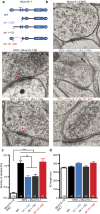Heterodimerization of Munc13 C2A domain with RIM regulates synaptic vesicle docking and priming
- PMID: 28489077
- PMCID: PMC5436228
- DOI: 10.1038/ncomms15293
Heterodimerization of Munc13 C2A domain with RIM regulates synaptic vesicle docking and priming
Abstract
The presynaptic active zone protein Munc13 is essential for neurotransmitter release, playing key roles in vesicle docking and priming. Mechanistically, it is thought that the C2A domain of Munc13 inhibits the priming function by homodimerization, and that RIM disrupts the autoinhibitory homodimerization forming monomeric priming-competent Munc13. However, it is unclear whether the C2A domain mediates other Munc13 functions in addition to this inactivation-activation switch. Here, we utilize mutations that modulate the homodimerization and heterodimerization states to define additional roles of the Munc13 C2A domain. Using electron microscopy and electrophysiology in hippocampal cultures, we show that the C2A domain is critical for additional steps of vesicular release, including vesicle docking. Optimal vesicle docking and priming is only possible when Munc13 heterodimerizes with RIM via its C2A domain. Beyond being a switching module, our data suggest that the Munc13-RIM heterodimer is an active component of the vesicle docking, priming and release complex.
Conflict of interest statement
The authors declare no competing financial interests.
Figures






Similar articles
-
Heterodimerization of UNC-13/RIM regulates synaptic vesicle release probability but not priming in C. elegans.Elife. 2019 Feb 25;8:e40585. doi: 10.7554/eLife.40585. Elife. 2019. PMID: 30802206 Free PMC article.
-
Disentangling the Roles of RIM and Munc13 in Synaptic Vesicle Localization and Neurotransmission.J Neurosci. 2020 Dec 2;40(49):9372-9385. doi: 10.1523/JNEUROSCI.1922-20.2020. Epub 2020 Nov 2. J Neurosci. 2020. PMID: 33139401 Free PMC article.
-
RIM proteins activate vesicle priming by reversing autoinhibitory homodimerization of Munc13.Neuron. 2011 Jan 27;69(2):317-31. doi: 10.1016/j.neuron.2011.01.005. Neuron. 2011. PMID: 21262469 Free PMC article.
-
Unc13 Aligns SNAREs and Superprimes Synaptic Vesicles.Neuron. 2017 Aug 2;95(3):473-475. doi: 10.1016/j.neuron.2017.07.017. Neuron. 2017. PMID: 28772115 Review.
-
Vesicle pools, docking, priming, and release.Cell Tissue Res. 2006 Nov;326(2):393-407. doi: 10.1007/s00441-006-0243-z. Epub 2006 Jul 4. Cell Tissue Res. 2006. PMID: 16819626 Review.
Cited by
-
RIM-BP2 primes synaptic vesicles via recruitment of Munc13-1 at hippocampal mossy fiber synapses.Elife. 2019 Sep 19;8:e43243. doi: 10.7554/eLife.43243. Elife. 2019. PMID: 31535974 Free PMC article.
-
Diacylglycerol-dependent hexamers of the SNARE-assembling chaperone Munc13-1 cooperatively bind vesicles.Proc Natl Acad Sci U S A. 2023 Oct 31;120(44):e2306086120. doi: 10.1073/pnas.2306086120. Epub 2023 Oct 26. Proc Natl Acad Sci U S A. 2023. PMID: 37883433 Free PMC article.
-
Molecular definition of distinct active zone protein machineries for Ca2+ channel clustering and synaptic vesicle priming.bioRxiv [Preprint]. 2023 Oct 30:2023.10.27.564439. doi: 10.1101/2023.10.27.564439. bioRxiv. 2023. Update in: Nat Neurosci. 2024 Sep;27(9):1680-1694. doi: 10.1038/s41593-024-01720-5. PMID: 37961089 Free PMC article. Updated. Preprint.
-
The evolution of synaptic and cognitive capacity: Insights from the nervous system transcriptome of Aplysia.Proc Natl Acad Sci U S A. 2022 Jul 12;119(28):e2122301119. doi: 10.1073/pnas.2122301119. Epub 2022 Jul 8. Proc Natl Acad Sci U S A. 2022. PMID: 35867761 Free PMC article.
-
Mechanisms that regulate the C1-C2B mutual inhibition control functional switch of UNC-13.Elife. 2025 Apr 11;14:RP105199. doi: 10.7554/eLife.105199. Elife. 2025. PMID: 40215098 Free PMC article.
References
-
- Siksou L. et al.. A common molecular basis for membrane docking and functional priming of synaptic vesicles. Eur. J. Neurosci. 30, 49–56 (2009). - PubMed
-
- Imig C. et al.. The morphological and molecular nature of synaptic vesicle priming at presynaptic active zones. Neuron 84, 416–431 (2014). - PubMed
Publication types
MeSH terms
Substances
Grants and funding
LinkOut - more resources
Full Text Sources
Other Literature Sources
Molecular Biology Databases

